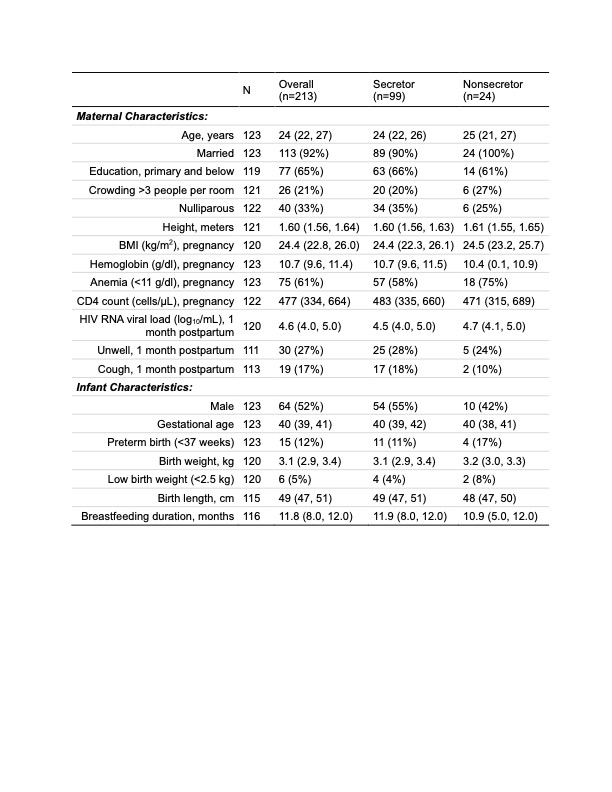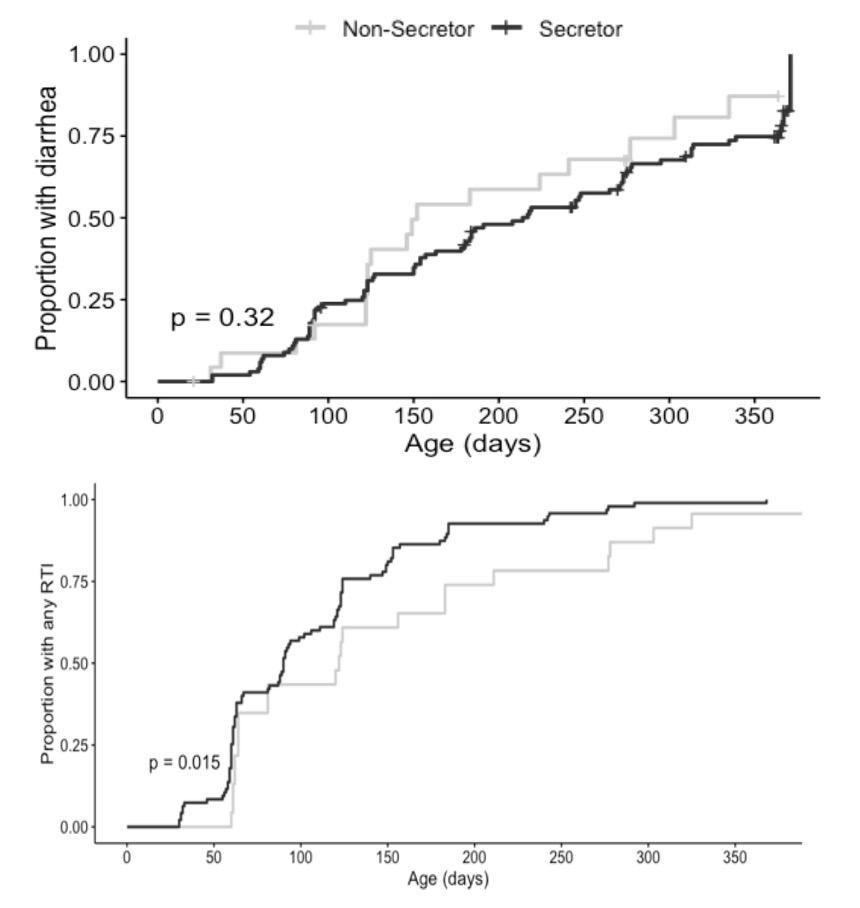Global Neonatal & Children's Health 1
Session: Global Neonatal & Children's Health 1
723 - Human Milk Oligosaccharides and Associations with Diarrhea and Acute Respiratory Tract Infection among Infant HIV Exposed Uninfected in Kenya
Friday, April 25, 2025
5:30pm - 7:45pm HST
Publication Number: 723.5197
D. Taylor Hendrixson, University of Washington School of Medicine, Seattle, WA, United States; Ruchi Tiwari, University of Washington, Poway, CA, United States; Emily L. Deichsel, Amgen, Baltimore, MD, United States; Kristjana H. Ásbjörnsdóttir, University of Iceland, Reykjavik, Hofuoborgarsvaoio, Iceland; Ruth Nduati, University of Nairobi, Nairobi, Nairobi Area, Kenya; Lars Bode, University of California, San Diego, La Jolla, CA, United States; Judd L. Walson, Johns Hopkins University, Baltimore, MD, United States; Grace John-Stewart, University of Washington School of Medicine, Seattle, WA, United States; Christine J. McGrath, University of Washington School of Medicine, Seattle, WA, United States

David Hendrixson, MD
Assistant Professor
University of Washington School of Medicine
Seattle, Washington, United States
Presenting Author(s)
Background: Human milk oligosaccharides (HMOs) are the third largest solid component in human milk (HM), functioning as prebiotics and immune system modulators. Women living with HIV have unique HMO profiles, including higher amounts of 3’sialylactose (3’SL), which has been associated with increased HIV transmission risk. Infants HIV-exposed uninfected (iHEU) have increased infectious morbidity compared to unexposed peers. This risk may be mediated by differences in maternal HMOs.
Objective: We investigated associations between HMOs and incidence of diarrhea and respiratory tract infections (RTI) among iHEU in the first year of life.
Design/Methods: Using a subset of data from a pre-antiretroviral therapy birth cohort of iHEU surviving to 1 year in Nairobi, Kenya, we assessed infant morbidity monthly from birth to 12 months. Total and individual HMO concentrations were quantified in banked HM samples collected at 1 month postpartum. Maternal secretor status was defined by the presence of >6% of 2’-fucosyllactose (2’FL) and Lacto-N-fucopentaose (LNFP) I. Anderson-Gill models allowing for repeat episodes were used to estimate incidence of diarrhea and RTI by secretor status, correcting for multiple comparisons. Kaplan-Meier curves using log-rank test for cumulative incidence were constructed.
Results: The 123 iHEU experienced an average of 2.01 episodes of diarrhea and 4.31 episodes of RTI in the first year of life. Most (80%) mothers were secretors (Table 1). Median breastfeeding duration was 11.8 months (interquartile range 8-12). Higher concentrations of 3’SL (Hazard ratio [HR] 1.46; 95% confidence interval 1.11-1.94) was associated with increased diarrhea risk among infants of secretors, while higher total sialylated (HR 0.15; 0.05-0.47), 6’SL (HR 0.44; 0.29-0.67), and DFLac (HR 0.70; 0.56-0.88) were associated with decreased diarrhea risk among infants of non-secretors (Figure 1). Higher DSLNH was associated with decreased risk of RTI among infants of both secretors (HR 0.87; 0.78-0.96) and non-secretors (HR 0.87; 0.78-0.98). Among infants of non-secretors, FLNH (HR 1.58; 1.29-1.92) and DFLNH (HR 2.01; 1.52-2.66) increased RTI risk. P-values remained significant after correction for multiple comparisons. Infants of secretors experienced a higher cumulative incidence of RTI compared to infants of non-secretors (p=0.015, Figure 2).
Conclusion(s): HMOs associated with the risk of diarrhea and RTI differed among infants of secretors and non-secretors. DSLNH was associated with decreased RTI risk in all infants. Increasing exposure to specific HMOs, like DSLNH, may be a strategy to reduce morbidity among vulnerable iHEU.
TABLE 1. Characteristics of breastfeeding women living with HIV and their HIV-exposed uninfected infants
 Values expressed as n(%) or median (quartile 1, quartile 3)
Values expressed as n(%) or median (quartile 1, quartile 3)Figure 1. Incidence of diarrhea1 and respiratory tract infections2 in the first year of life by human milk oligosaccharides (HMOs) and maternal secretor status
.jpg) 1Incidence of diarrhea, allowing repeat episodes with a 14-day window for new episodes
1Incidence of diarrhea, allowing repeat episodes with a 14-day window for new episodes 2Incidence of RTI, allowing repeat episodes and with a 14-day window for new episodes
*Denotes statistical significance after adjustment for multiple comparisons using using Benjamini-Hochberg procedure.
Abbreviations: DFLac- difucosyllactose ; DFLNH- difucosyllacto-N-hexaose ;DFLNT- difucosyllacto-N-tetrose; DSLNH- disialyllacto-N-hexaose; DSLNT- disialyllacto-N-tetraose; 2’FL- 2’-fucosyllactose; 3’FL- 3’-fucosyllactose; FDSLNH- fucosyldisialyllactose-N-hexaose I; LNFP- lacto-N-fucopentaose; LStb- sialyl-lacto-N-tetraose; 3’SL- 3’-sialyl lactose; 6’SL- 6’ sialyl lactose
Figure 2. Kaplan-Meier Curve for cumulative incidence by log-rank test of A) diarrhea and B) respiratory tract infection (RTI) stratified by secretor status.

TABLE 1. Characteristics of breastfeeding women living with HIV and their HIV-exposed uninfected infants
 Values expressed as n(%) or median (quartile 1, quartile 3)
Values expressed as n(%) or median (quartile 1, quartile 3)Figure 1. Incidence of diarrhea1 and respiratory tract infections2 in the first year of life by human milk oligosaccharides (HMOs) and maternal secretor status
.jpg) 1Incidence of diarrhea, allowing repeat episodes with a 14-day window for new episodes
1Incidence of diarrhea, allowing repeat episodes with a 14-day window for new episodes 2Incidence of RTI, allowing repeat episodes and with a 14-day window for new episodes
*Denotes statistical significance after adjustment for multiple comparisons using using Benjamini-Hochberg procedure.
Abbreviations: DFLac- difucosyllactose ; DFLNH- difucosyllacto-N-hexaose ;DFLNT- difucosyllacto-N-tetrose; DSLNH- disialyllacto-N-hexaose; DSLNT- disialyllacto-N-tetraose; 2’FL- 2’-fucosyllactose; 3’FL- 3’-fucosyllactose; FDSLNH- fucosyldisialyllactose-N-hexaose I; LNFP- lacto-N-fucopentaose; LStb- sialyl-lacto-N-tetraose; 3’SL- 3’-sialyl lactose; 6’SL- 6’ sialyl lactose
Figure 2. Kaplan-Meier Curve for cumulative incidence by log-rank test of A) diarrhea and B) respiratory tract infection (RTI) stratified by secretor status.


